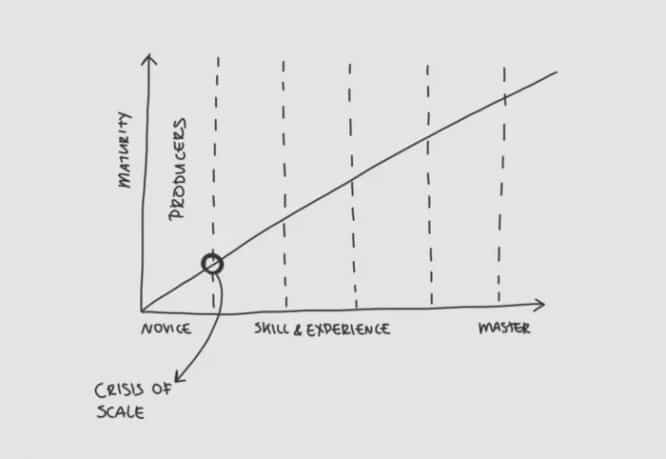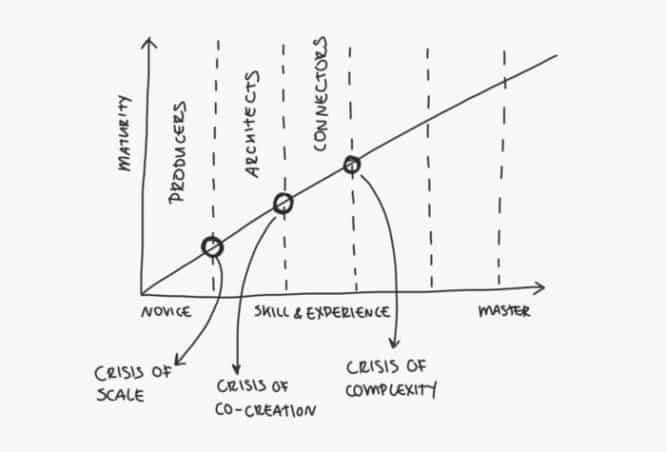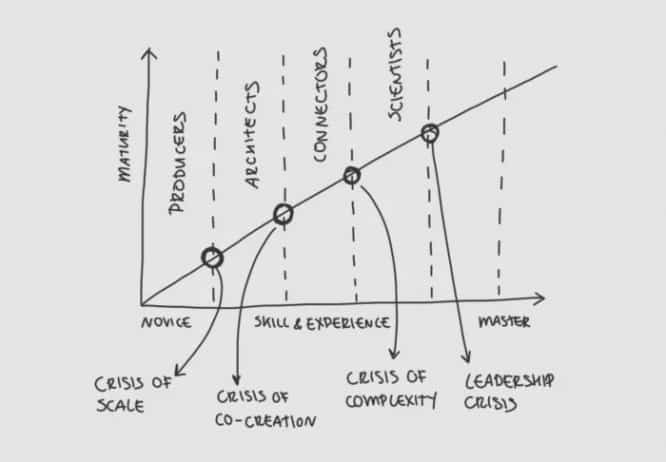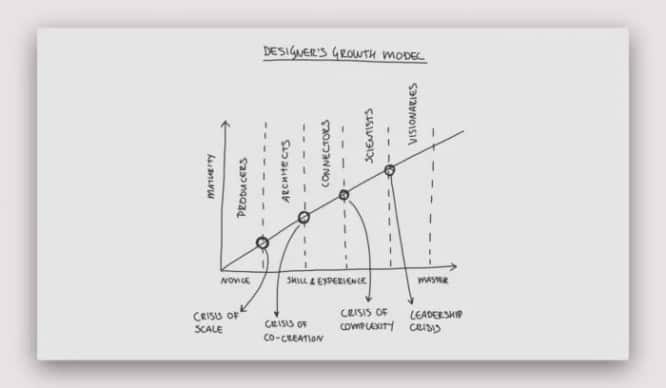5 stages of designer development
5 stages of designer development
Translation of material by Dennis Humbekers, strategic design consultant at Zuiderlicht.
The designer goes through several stages of development. Each is distinguished by its own set of requirements, goals and the nature of the work.
Based on the Invision Design Frontier report and Greiner’s growth model (good designers copy, great designers steal), I created a designer evolution model.
Like Greiner’s famous growth model, my model has different phases. It also has crises of transition from one phase to another (never miss the opportunity of a crisis). I have slightly rearranged the maturity stages from the Invision model. Mixing two models (everything is a mixture of something), I move on to one – a new one.
Stage one: manufacturers
The beginning of design is about creating beautiful things. This is a foundational skill for a designer. What is taught in art school. That’s why designers become designers: to create beauty.
This is what makes the design attractive. What most people think about design. What is shown in museums when the theme of the exhibition is design: a designer as a creator of beautiful things.
Its tools are those from the classic Adobe design suite. His skills are the rules of aesthetics: layout, space, rhythm, color, shape. Growth comes with mastery of tools and the skill of creating more beautiful things.
Crisis one: scale
It comes when a designer succeeds. The more professional the designer is, the larger the projects available. He has to collaborate with more and more people and design systems on a larger scale.
There is a need for collaboration tools and tools for designing entire systems instead of creating separate objects. To his skill set, he is forced to add the skills of systems thinking and teamwork. For a designer accustomed to working alone on a specific object, this step can be a major hurdle.

Stage two: architects
When designers have overcome the complexities of systems thinking and teamwork, they become architects. They now work with large design teams and build systems instead of individual objects.
They use modern tools that make it easy to collaborate and design multiple elements. Growth comes with the ability to work in a team and think systematically.
Crisis two: co-creation
An architect works with designers, and together, based on briefs, they develop ready-made solutions. Design is still isolated from the rest of the business. However, there is more to it than creating separate objects. Design has a lot of influence because it is larger in scale. It ranks high on the strategic agenda.
But the work is carried out by designers on assignment from the business. If they are aiming for greater impact, the next hurdle they must overcome is opening up the design process to all parties interested in solving the problem. They should become problem solvers, not project developers. It’s a big leap for a designer to let other people into the process.

Stage three: connecting links
If a designer can connect with all stakeholders and have the skill to simplify things, they can find better solutions. If a designer is aware of the issues and needs of stakeholders, he has much more influence.
One of the main stakeholders is the end user of the product, but there are others. Designers are in the ideal position to connect user needs with business needs and technology opportunities.
Designers should:
- Develop simplification skills for organizing workshops.
- Work with prototypes to solve problems more efficiently.
- Understand the language of business and technology for establishing communications.
Crisis three: complexity
When a designer becomes a bridge between user requests, business needs and technological capabilities, when he can bring ideas together, he is able to develop solutions that meet the interests of all parties.
This will allow projects to become much more successful. And everything goes great until the designer is faced with the next obstacle – complexity.
Even if you have done all the research, collected all the ideas that you can get during creative meetings, and predicted all possible communication problems, you may find that the task at hand is too difficult to come up with a solution, and then continue developing it.
Implementation of large-scale projects requires a lot of time and money. And in our complex world, most solutions simply do not work well enough, do not fulfill the set requirements. Either the world changes as soon as your design is done, or it turns out that people are not behaving the way you intended.
To solve this problem, designers have to do science: create hypotheses, conduct experiments, and analyze results. They have to move from design for the sake of solving a problem to design for the sake of learning. For a designer who thinks in terms of art, this shift to a more scientific, analytical approach can be a real shift in consciousness.

Stage four: scientists
Scientists can use their design skills alongside their analytical skills to evolve, learn, and adapt. They can build, measure, study and apply their unique design perspective, mindset, and skills to take projects to the next level.
A hybrid art design approach combined with analytic science allows you to create projects with greater value, reducing risk and increasing productivity. Scientists use their own prototypes to gather information, validate directions, and guide the development process.
Abstract thinking, the ability to create specific objects, creativity, courage, the ability to see connections – all this contributes to the emergence of a high-quality and successful project.
Designers with such qualities no longer complete tasks, but recreate them, turning them into exciting, exciting challenges. Because real problems are solved with constantly validated actions, the research designer creates tremendous value.
In the alternative futures they are involved in creating, they are able to change people. And when they discover their superpower, they want more. They will want to pass the final test. They will want maximum impact: change people with their vision.
Crisis four: leadership
It is then that they face the final crisis. They need to develop their leadership skills. When they were architects, they were already managing project teams. But now things have changed: now they influence not only other designers, they influence entire organizations. They need to learn how to do business and management, and understand how businesses operate.
It’s not just about learning to speak the language of business, as it was when they were connecting links. This is another step forward. They must know how current managers think and work, must be able to design the organization in an alternative way.
To break the rules, they must first learn them. Must learn to be leaders. Let them be different leaders than traditional MBA executives, but they must master the art of trading.

Stage five: the seers
A visionary can apply their skills, intelligence, and toolbox to solving business problems. Design allows you to look at strategy, organization, leadership from a completely different angle. Designers are able to transform companies by creating visions for the future and roadmaps to get there.
Metrics and facts do not change organizations, but a new vision of the future can do it. There is a growing need for a new kind of leadership in companies – leadership based on imagination. A vivid image can be a driving force for change. The ability to think big, courage, creativity – that’s what you need in business today. And designers are in a great position to bring that to leadership.

Source: Medium
…


